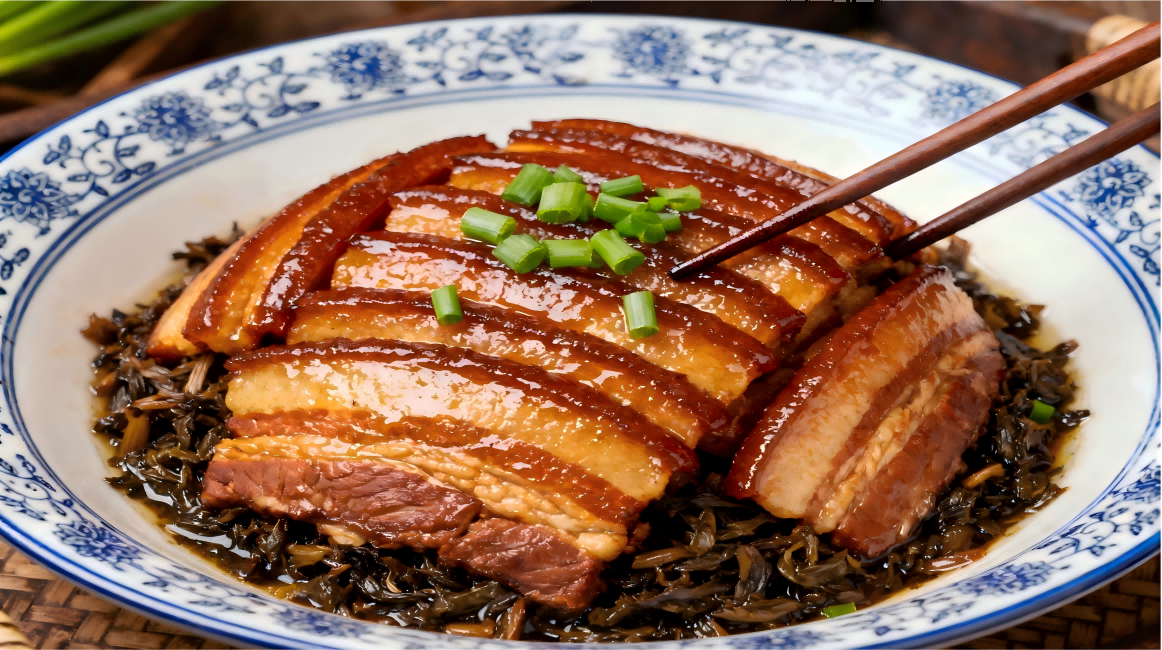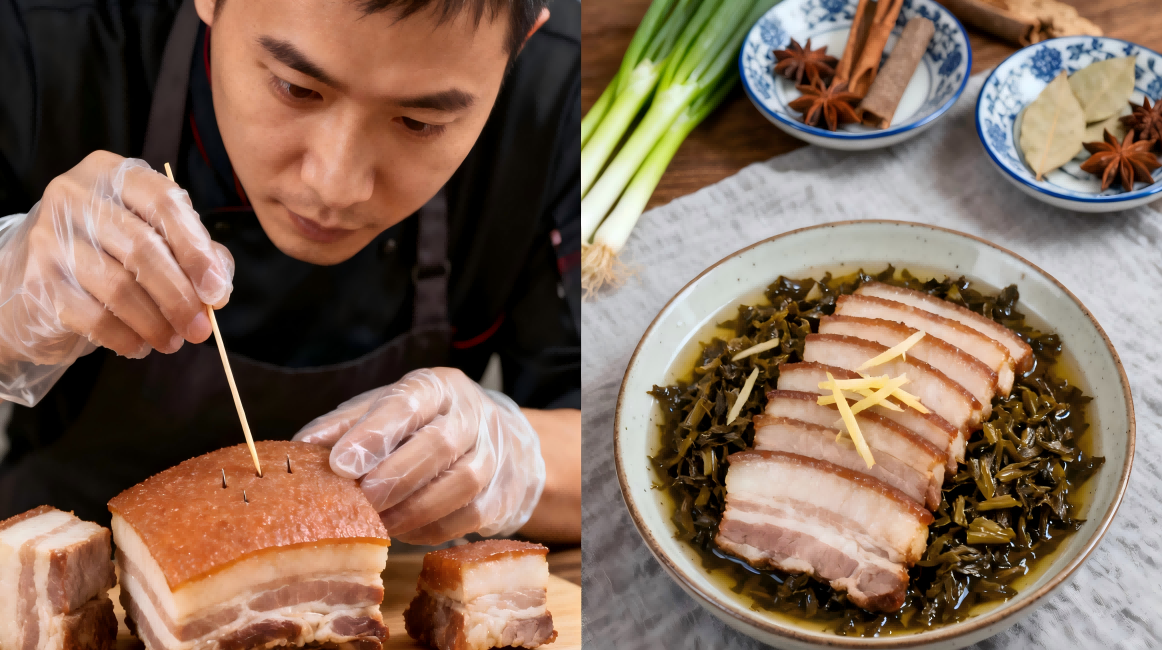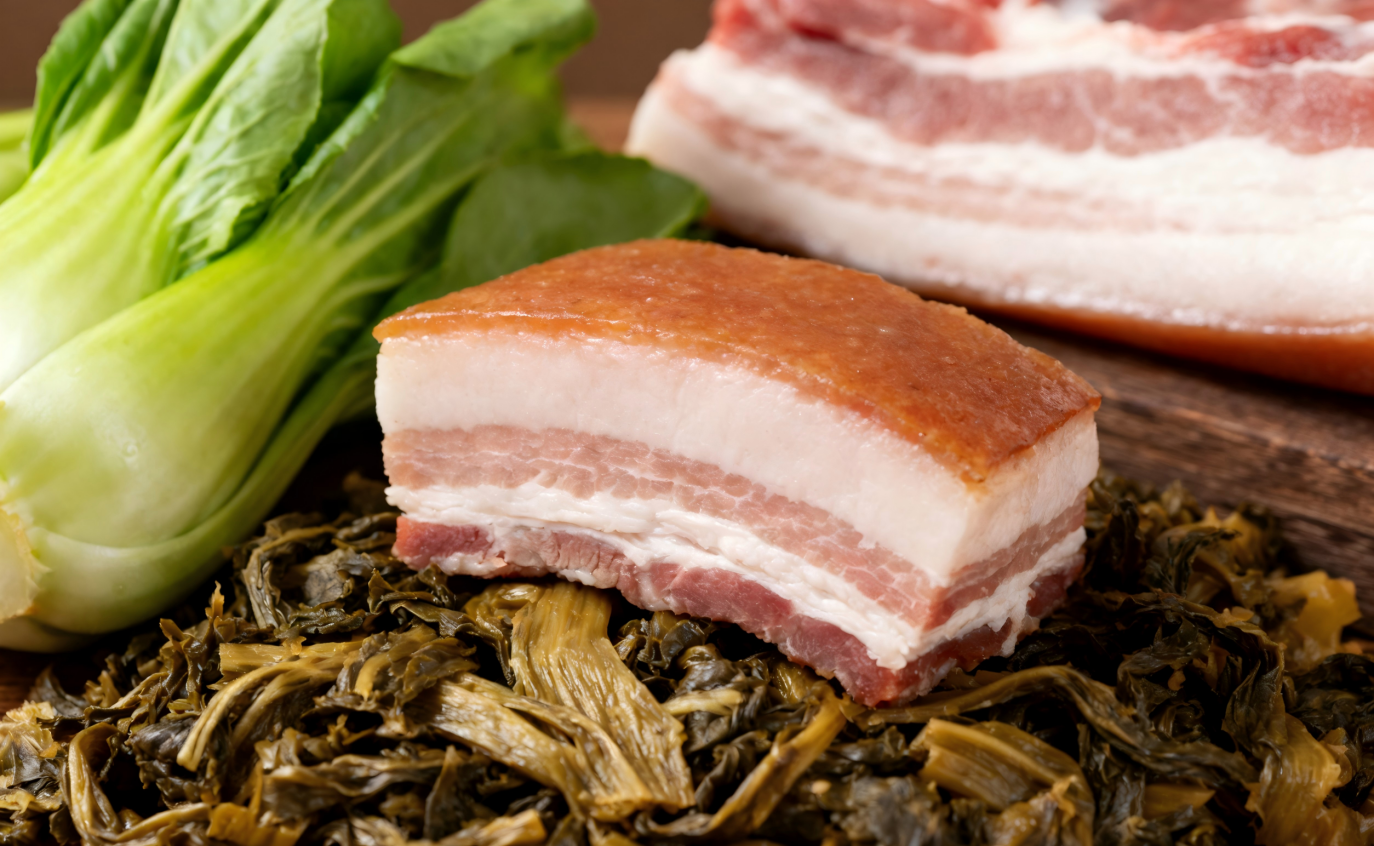
A Feast for the Senses: An Irresistible Flavor Symphony
The visual appeal is stunning at first glance: golden brown mei cai wraps around reddish-brown pork slices, with the pork skin glowing brightly. The fried surface forms a natural honeycomb pattern, resembling tiger skin texture. Drawing near, the rich aroma of pork fat blends with the dried fragrance of mei cai, rising together. The sauce aroma carries a hint of sweetness—rich yet not heavy—immediately awakening taste memories.
The taste is even more multi-layered: the fatty parts have long lost their greasiness, turning into translucent jelly after prolonged steaming, melting in the mouth. The lean meat soaks up the sauce, tender yet not tough, with every fiber filled with the balanced flavor of salt and sweetness. As the soul of the dish, mei cai fully absorbs the essence of the meat juice, becoming soft, glutinous and fragrant. Each bite combines the chewy texture of dried vegetables with the richness of meat, achieving the flavor balance of salty-sweet and fresh-not-greasy that embodies the essence of Hakka cuisine. Paired with a bowl of white rice, the sauce-soaked grains collide with the braised pork—truly the ultimate interpretation of a "rice companion."
Craftsmanship: A Thousand-Year-Old Culinary Philosophy

This famous dish, hailed as one of the "Three Treasures of Hakka Cuisine," carries the Dongjiang Hakka cuisine production technique, which was listed as a municipal intangible cultural heritage in 2011. Its production process is complex yet full of ingenuity. Ingredient selection is the first hurdle: pork belly must be the middle section with skin, with the fat-to-lean ratio strictly controlled at 4:6. The ideal choice has intact skin and white fat. For mei cai, Huizhou large-leaf mei cai is preferred, made through manual sun-drying and pickling. After soaking, it needs repeated rinsing to remove sand, then stir-fried with sugar to enhance the sweet aftertaste.
Five core steps are indispensable: blanching in cold water to remove fishiness and set shape; pricking holes while hot, brushing with vinegar, and frying to form a tiger skin texture; slicing into 2-centimeter-thick pieces and marinating in sauce made of dark soy sauce, fermented tofu, and five-spice powder; spreading stir-fried mei cai over the pork; and finally slow-steaming over low heat for 1.5 to 2 hours. This long cooking process is a vivid practice of the Chinese culinary philosophy of "drawing out the inherent flavors of ingredients and infusing flavors into those lacking them." It allows the fat of the pork and the fragrance of mei cai to penetrate each other, ultimately achieving a state of harmony and unity. Each step embodies the craftsman's experience—too little heat leaves the meat tough, and skipping a marination step results in insufficient flavor. Time and patience are the best seasonings for this dish.
Health and Nutrition: A Natural Gift of Complementary Ingredients

Despite its seemingly rich and fatty appearance, mei cai braised pork belly hides a scientific nutritional combination. As a high-quality protein source, pork belly contains 9.3 grams of protein per 100 grams. It also provides easily absorbable heme iron and cysteine that promotes iron absorption, effectively improving iron-deficiency anemia. Its abundant collagen is converted into gelatin through stewing, which is beneficial for skin elasticity and joint health. The nutrition of mei cai is equally remarkable: after drying and pickling, its dietary fiber content reaches 15.58 grams per 100 grams—1.5 times that of fresh mustard greens—promoting gastrointestinal peristalsis. The content of minerals such as calcium, potassium, and iron doubles. Total flavonoids and phenolic compounds endow it with antioxidant activity, while organic acids stimulate appetite and aid digestion.
The combination of the two is perfect: the dietary fiber in mei cai can absorb some oil, reducing the greasiness of the dish. The fat-soluble vitamins in pork belly promote the absorption of minerals in mei cai, achieving nutritional complementarity. According to traditional Chinese medicine, pork is neutral in nature and sweet in taste, with the effects of tonifying the kidney, nourishing blood, nourishing yin and moistening dryness. Mei cai can clear heat and relieve summer heat, resolve stagnation and invigorate the stomach. Eating them together satisfies both taste buds and physical conditioning—no wonder it has become a staple dish for festivals and banquets, symbolizing reunion and prosperity.
From the stoves of Hakka mountain villages to today's banquet tables, mei cai braised pork belly has been passed down for hundreds of years, transcending its identity as just a dish. It is a flavor tempered by time, a craft upheld by ingenuity, and a warm taste of family reunion. Each soft, glutinous, fresh and fragrant bite contains the wisdom of Chinese food culture, inviting you to savor this delicious legend spanning thousands of years.



